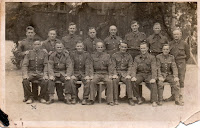List of POWs at BAB21. Page 36

The following list contains approx 600 names of men captured during May and June 1940, and admitted to Bau und Arbeits Battalion 21. After capture, the men were marched and entrained into captivity being admitted for registration at camps in Poland. Stalag XX1B. XX1D. XX1C. XX1C/H. Interestingly, apart from a few exceptions the majority of the prisoners admitted to BAB21 all had low POW numbers. The higher numbers could have been admitted at a later date.

